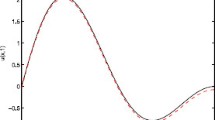Conclusion
The results presented in § 1 and § 2 can serve as a basis for further study of equations like (1.1), (2.1)–(2.3). For example, using the obtained estimates for a solution u(x,t) together with the well-known estimates for solutions to the Cauchy problem or the maximum principle for parabolic equations [6, 7], we can easily obtain estimates for the derivativesu t (x, t),u tt (x, t), etc., as well as estimates for the derivatives with respect to the space variables.
Concluding the article, we note that, in our opinion, together with the questions of existence and nonexistence of smooth solutions it is worthwhile to study some questions that concern qualitative properties of solutions to the considered equations, for example the questions of localization of solutions and some other questions.
Similar content being viewed by others
References
Y. Yamada, “On a certain class of semilinear Volterra diffusion equations,” J. Math. Anal. Appl.,88, No. 2, 433–451 (1982).
Y. Yamada, “Asymptotic stability for some systems of semilinear Volterra diffusion equations,” J. Differential Equations,52, No. 3, 295–326 (1984).
H. Engler, “On some parabolic integro-differential equations: existence and asymptotics of solutions,” Lecture Notes in Math.,1017, Springer, Berlin etc., 1983, pp. 161–167).
M. L. Heard and S. M. Rankin III, “A semilinear parabolic Volterra integro-differential equation,” J. Differential Equations,71, No. 2, 201–233 (1988).
G. Jong-Sheng and S. Hsuan-Wen, “The blow-up behavior of the solutions of an integro-differential equations,” Differential Integral Equations,5, No. 6, 1237–1245 (1992).
A. A. Samarskiî, V. A. Galaktionov, S. P. Kurdyumov, and A. P. Mikhaîlov, Regimes with Peaking in Problems for Quasilinear Parabolic Equations [in Russian], Nauka, Moscow (1987).
A. Friedman, Partial Differential Equations of Parabolic Type [Russian translation], Mir, Moscow (1968).
A. I. Kozhanov, Comparison Theorems and Solvability of Boundary Value Problems for Some Classes of Evolution Equations of Pseudoparabolic and Pseudohyperbolic Type [Preprint, No. 17] [in Russian], Inst. Mat. (Novosibirsk), Novosibirsk (1990).
Ton Bui An, “Nonlinear evolution equations of Sobolev-Galpern type,” Math. Z.,151, 219–233 (1976).
G. F. Webb, “Existence and asymptotic behavior for a strongly damped nonlinear wave equation,” Canad. J. Math.,32, No. 3, 631–643 (1980).
P. Aviles and J. Sandefur, “Nonlinear second order equations with applications to partial differential equations,” J. Differential Equations,58, No. 3, 404–427 (1985).
J. M. Ghidaglia and A. Marzocchi, “Longtime behavior of strongly damped wave equations, global attractors and their dimension,” SIAM J. Math. Anal.,22, No. 4, 879–895 (1991).
Author information
Authors and Affiliations
Additional information
Translated fromSibirskiî Matematicheskiî Zhurnal, Vol. 35, No. 5, pp. 100–1005, September–October, 1994.
Rights and permissions
About this article
Cite this article
Kozhanov, A.I. Parabolic equations with nonlocal nonlinear source. Sib Math J 35, 945–956 (1994). https://doi.org/10.1007/BF02104572
Received:
Issue Date:
DOI: https://doi.org/10.1007/BF02104572



